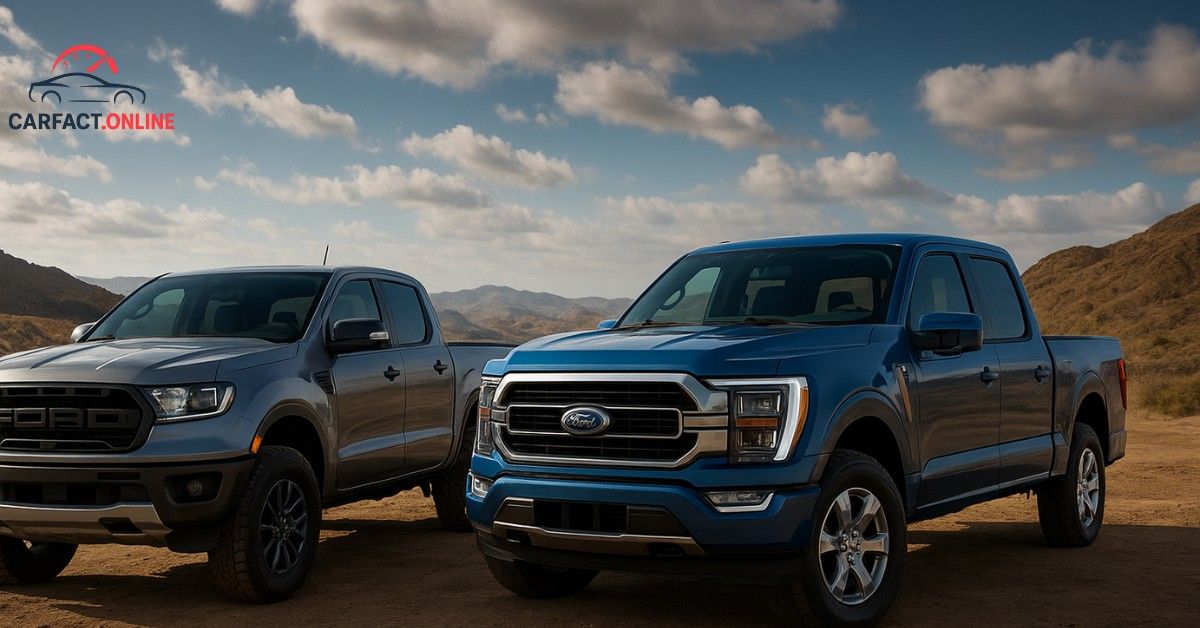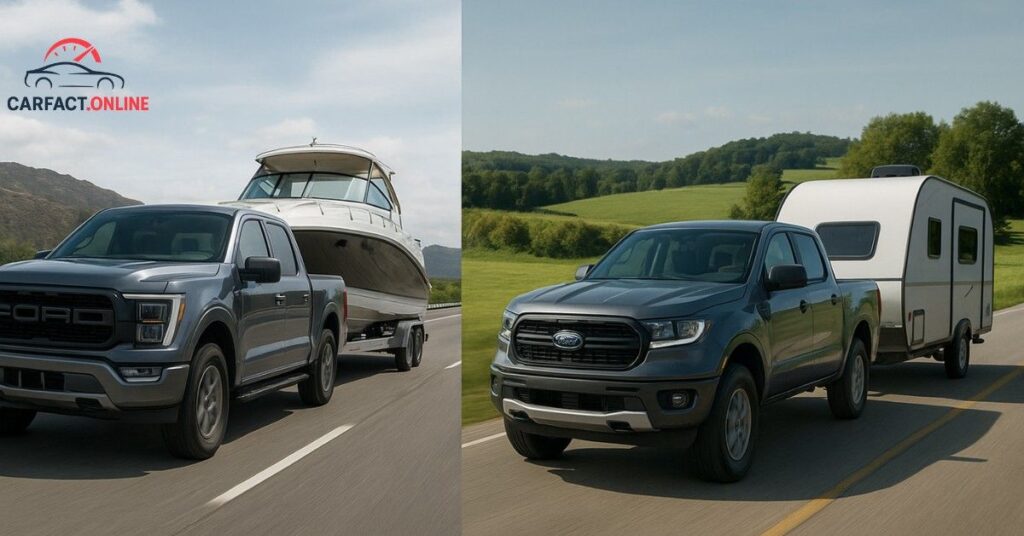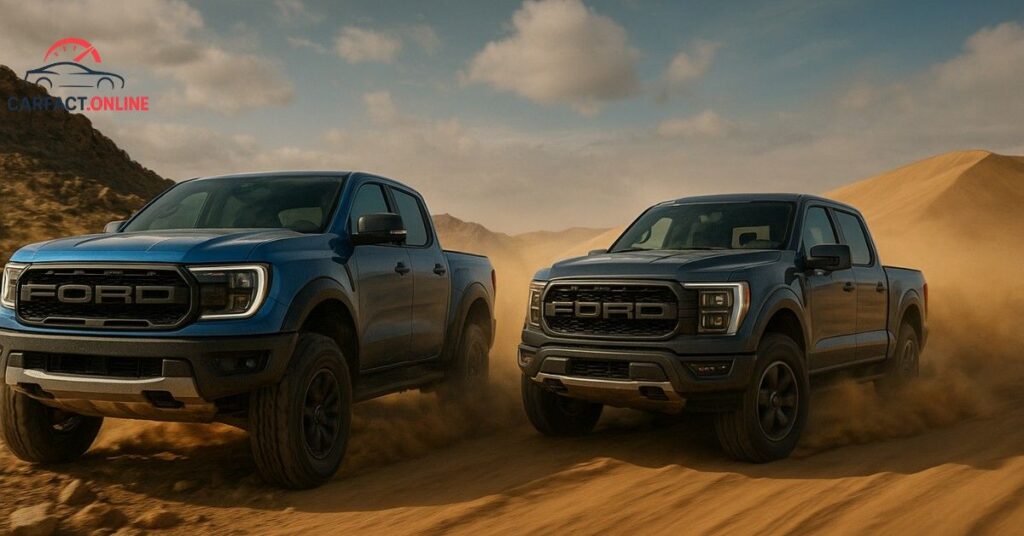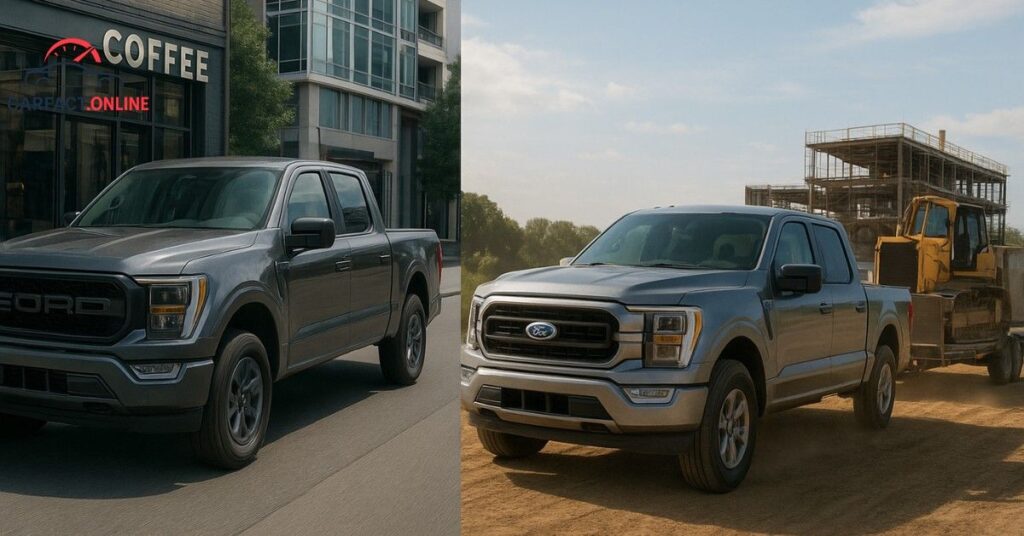Ford Ranger vs Ford F-150: 2025 Comparison & Buyer’s Guide

In case you are in need of an efficient pickup that you cannot choose between the Ford Ranger and Ford F-150, you are not alone. These two have a lot in common in terms of heritage, however, they are sold in various segments midsize and full-size, therefore, allow people to have different needs. To make this comparison we will delve into engines, towing, payload, dimensions, features, pros and cons, and finally guide you into making a decision of which is better between the Ford Ranger or F-150 in your application.
Below we will compare and contrast their advantages and disadvantages, insights into their use in the real-world, and a definite verdict. We can begin by laying the scene.
Overview: Ford Ranger vs Ford F-150 — What class do they serve?
Ford Ranger is a midsize pickup, which targets consumers who desire utility, maneuverability and lower price. Ford F-150 is a full size truck, constructed to carry heavier load, pull larger and wider. It is quite appropriate to call them Ford Ranger vs F-150 specs, they do have common DNA, however, the F-150 is just a different level in a number of ways.
In 2025, both have evolved. The Ranger comes with new powertrain improvements and sharper handling, and F-150 still goes to extremes with a variety of engines, hybrid, and high tech. We can divide their differences, bit by bit.
Key Differences at a Glance
| Category | Ford Ranger (2025) | Ford F-150 (2025) |
| Segment | Midsize pickup | Full-size pickup |
| Base Engine | 2.3L EcoBoost I-4, 270 hp, 310 lb-ft | Multiple options, e.g. 2.7L EcoBoost V6, 3.5L EcoBoost, 5.0L V8, PowerBoost hybrid, etc. |
| Top Engine (Raptor) | 3.0L EcoBoost V6, ~405 hp, 430 lb-ft | High-output 3.5L EcoBoost for Raptor, supercharged 5.2L V8 in Raptor R, hybrid, etc. |
| Transmission | 10-speed automatic | 10-speed automatic (varies by engine) |
| Max Towing | ~7,500 lbs (with trailer tow package) | Up to ~13,500 lbs (with 3.5L EcoBoost) |
| Max Payload | Lower (varies by trim) | Up to ~2,440 lbs in certain configs |
| Dimensions | More compact length, width, turning radius | Much larger in most configurations |
| Price Range | Lower entry-level cost | Higher cost, especially in high trims/hybrid/raptor |
| Fuel Economy | Better relative to its class | Dependent on engine — heavier weight often reduces MPG |
| Off-Road & Capability | Ranger Raptor is strong off-road contender | F-150 with Raptor / Tremor / off-road packages pushes capability further |
| Daily Usability | Easier in city, better maneuverability | More presence, more bulk, but more capability |
| Cost of Ownership | Lower in many cases (fuel, insurance, etc.) | Higher in many cases (maintenance, tires, insurance) |
This table offers a snapshot. In the sections below, we’ll dive deeper into each category.
Engine Options & Performance
Ford Ranger Engine Lineup
The 2025 Ranger has a base 2.3L EcoBoost turbocharged inline-4 that produces 270 horsepower and 310 lb-ft of torque. Higher trims and packages also offer a 2.7L twin-turbo V6 (around 315 hp), while the extreme Ranger Raptor pushes a 3.0L EcoBoost V6 with ~405 hp and 430 lb-ft torque for dedicated off-road performance.
These engines are paired with a 10-speed automatic transmission and available in rear-wheel drive or 4×4 depending on trim.
Ford F-150 Engine Lineup
The F-150 offers multiple engine options—from modest to extreme:
- 2.7L EcoBoost V6 (a lower powered engine)
- 3.3L naturally aspirated V6 in entry versions (less potent)
- 3.5L EcoBoost (twin-turbo V6) with high performance (often used in Raptor)
- 3.5L PowerBoost hybrid V6 to be even more efficient and good torque output.
- The F-150 Raptor R in performance trims comes with a 5.2L supercharged V8 that has 720 hp and 640 lb-ft of torque.
Each of the major engines has a 10-speed automatic (or equivalent) transmission.You can explore official engine specs and configurations directly on Ford’s Official 2025 F-150 page.
Performance & Acceleration Comparison
In everyday driving, the Ranger’s 270-hp 2.3L is plenty to merge, pass, and maneuver — especially given its lighter weight.The F-150, with stronger engine options, will offer significantly stronger acceleration in most variants, especially with the 3.5L EcoBoost or supercharged V8.
Off the line, the heavier F-150 will lag unless equipped with a powerful engine.For towing or heavy payloads, the F-150’s stronger engines (and frame) shine, allowing it to maintain speed and climbing capability under load.
Towing & Payload Capacity
These are often decisive factors for truck buyers — how much can you haul or tow?

Ford Ranger Towing & Payload
The Ranger’s maximum towing (with the right package) is about 7,500 lbs (when properly equipped) according to some dealer specs. Payload is significantly lower than F-150; exact payload depends heavily on trim, axle ratio, and equipment.
Because the Ranger is lighter, its payload with passengers will drop more fast compared to the F-150.
👉 For full details and towing specs, check our complete blog on 2025 Ford Ranger Towing Capacity.
Ford F-150 Towing & Payload
The 2025 F-150 offers up to 13,500 lbs of towing in some configurations (particularly the 3.5L EcoBoost). Payload maximums reach about 2,440 lbs in select configurations.
Even more modest F-150 engine versions (e.g. 2.7L) still offer respectable towing (~8,400 lbs) and payload (~1,775 lbs) in many configurations.
Real-world insight: If your typical load is under 5,000 lbs and you don’t need full-size towing, the Ranger can work well. But for heavier trailers, boats, campers, or commercial work, the F-150 gives you much more margin.
👉 For full details and towing specs, check our complete 2025 Ford F-150 Towing Capacity Guide.
Dimensions, Bed, & Maneuverability
Ford Ranger Dimensions
- The Ranger is more compact — shorter length and narrower width allow easier parking and tighter turns.
- It uses a crew cab configuration with a ~5-foot (5 ft) bed in many trims.
- Wheelbase and turning radius are more favorable for city and light-duty usage.
Ford F-150 Dimensions
- The F-150 comes in multiple cab and bed configurations — regular, SuperCab, SuperCrew, and bed lengths of ~5.5 ft, 6.5 ft, and longer.
- Its total length can span from ~209 inches (compact cab + short bed) up to ~243.5 inches for long-bed / extended cab models.
- Obviously, parking, maneuvering in tight spaces, and city driving are more challenging with the F-150, particularly in its larger configurations.
Implication: If urban life, tight driveways, or narrow roads are part of your world, Ranger gives you the advantage. The F-150 rewards you only when you need its extra size and capacity.
Fuel Economy & Efficiency
Ford Ranger Fuel Economy
- In EPA terms, the Ranger averages about 19 city / 26 highway MPG with its base 2.3L engine.
- Because it is lighter and less powerful than the F-150, its fuel consumption under moderate loads is generally more favorable.
Ford F-150 Fuel Economy
- The F-150’s fuel economy varies dramatically by engine, cab, body, and load. Kelley Blue Book lists combined MPG ranges of 19–21 MPG for typical variants.
- Heavier and performance engines (e.g. 5.0L, 3.5L EcoBoost, Raptor) will see lower MPG in real driving.
- The PowerBoost hybrid version helps claw back efficiency with better torque and lower consumption under lighter conditions.
Takeaway: In your daily non-loaded driving, the Ranger will usually be cheaper to fuel. But for heavy-duty use, the F-150’s strength may justify extra fuel costs.
Off-Road, Capability & Handling

Ford Ranger Off-Road Strengths
- The Ranger Raptor trim adds off-road hardware: robust suspension, FOX shocks, locking differentials, wider track, and drive modes like Baja.
- Its lighter weight helps agility off-road; easier to navigate tight trails.
- Ground clearance is around 10.7 inches in certain Ranger builds.
F-150 Off-Road Strengths
- The F-150 can be equipped with Raptor, Tremor, FX4, or other off-road packages.
- The Raptor version, especially, offers serious performance — handling dunes, trails, and desert runs with power to spare.
- Heavier build can help stability on rough terrain when carrying weight, but weight also penalizes in very technical terrain.
- Off-road advantage to the F-150 is more about capability with load and high-speed terrain; Ranger wins in tighter, moderate trails.
Interior, Comfort & Technology
Ford Ranger Interior & Features
- The Ranger comes with modern touches: SYNC 4 infotainment, Apple CarPlay / Android Auto, ambient lighting, and decent ergonomic layout.
- In upper trims you may get nicer finishes, power sliding rear window, all-weather mats, premium materials, etc.
- Cabin space is generally good for a midsize, but rear-seat legroom may trail that of an F-150 in many configurations.
F-150 Interior & Features
- F-150 offers a more spacious cabin in many configurations, especially with SuperCrew cabs.
- Advanced tech: large touchscreens (12-inch or bigger), Pro Trailer Backup Assist, Pro Trailer Hitch Assist, configurable driver-assist systems via Ford Co-Pilot360 (often standard).
- Luxury trims (King Ranch, Platinum) push into near-SUV territory in comfort and finish.
- Raptor or performance trims may sacrifice some luxury for ruggedness, but still deliver premium features in many cases.
Summary: F-150 generally has the edge in space and high-end features, especially in premium trims, while the Ranger balances practicality with cost and nimbleness.
Safety, Reliability & Ownership Costs
Safety & Ratings
- Both trucks benefit from Ford’s suite of driver-assist features (Co-Pilot360), though actual safety ratings vary by trim, cab, and region.
- Keep an eye on recalls: for example, the Ranger (2024–2026) has been recalled for a side-curtain airbag defect.
Reliability & Maintenance
- The simpler structure and lighter weight of the Ranger can translate to lower stress on components in many use cases.
- The F-150’s heavy-duty parts may last longer under hard conditions, but also may cost more to maintain (tires, brakes, suspension) due to extra weight and complexity.
- Fuel, insurance, and repair costs tend to be higher for F-150 in general.
Resale & Depreciation
- Full-size trucks like the F-150 often hold value well, especially in strong markets.
- The Ranger, being more modest and less expensive, may depreciate faster in dollar terms but could offer lower absolute loss.
- The desirability of off-road trims (Raptor) and efficient powertrains (hybrid) can help retain value.
Price & Cost of Ownership
- The Ranger starts at a substantially lower base price than the F-150. For instance, a 2025 Ranger XL with its base equipment is much cheaper than most F-150’s lowest trims.
- The F-150 base MSRP is often in a higher bracket; adding premium trims, hybrid or performance options pushes price significantly upward.
- Over time, costs like fuel, insurance, tires, brakes, and servicing are higher for the F-150 in many usage scenarios.
- However, if your usage fully exploits F-150’s capability (heavy towing, commercial use), your return on investment may offset higher costs.
Real-World Use Cases: Which Truck Fits You?

- Daily driver / city use with occasional hauling: The Ranger is typically more convenient, economical, and less burdensome in urban settings.
- Weekend adventures / off-road trails: Ranger Raptor shines in moderate to advanced off-road settings. If you add heavy gear or trailer, F-150 might be better.
- Towing boats, campers, trailers, work gear: F-150 gives you headroom and capability margin that Ranger may struggle to match.
- Commercial or heavy-duty use: F-150 tends to offer more flexibility in configurations, accessories, and robustness.
- Budget-conscious buyer: Ranger gives excellent value and lower total cost for many use cases.
Pros & Cons Quick Comparison
| Feature | Advantage: Ranger | Advantage: F-150 |
| Maneuverability / city use | Smaller footprint, easier to park | — |
| Fuel economy (light duty) | Lighter, efficient engines | Hybrid option gives a boost |
| Base cost | Lower entry price | More capability per dollar at high trims |
| Towing & payload | Decent for midsize class | Much stronger overall tow and payload |
| Interior space & comfort | Adequate for midsize expectations | Larger cabs, more room in many trims |
| Tech & features | Modern features in decent trims | More advanced features, towing aids |
| Off-road potential | Strong in moderate trail use | More extreme off-road capability with Raptor |
| Long-term cost | Lower maintenance in many scenarios | More durable under heavy duty, but costlier to maintain |
Conclusion
In this Ford Ranger vs Ford F-150, it does not have a single-size-fits-all answer that cannot be answered because the kind of use that a person has in mind can greatly influence the choice of the right model.
In case you put a high value on cost, every-day-driving convenience, mediocre utility, and occasional towing or off-road adventure, then the Ranger is a smart choice.
When you are in the world of heavy trailers, ambitious payloads, maximum flexibility and need robust performance, the F-150 stands where lighter trucks have to be.
To conclude: the Ranger is the perfect choice when you do not require full-size capability on a daily basis but the F-150 is the vehicle to go to when you need to have a tow, haul, and flexibility leader.
Discover expert car tips, towing guides, and vehicle insights at CarFact.online.
Frequently Asked Questions (FAQs)
Q: Which is better: Ford Ranger or F-150?
A: There’s no universal “better” — the Ranger excels in cost, maneuverability, and lighter-duty use. The F-150 wins when you need serious towing, payload, and full-size truck flexibility.
Q: Is the Ford Ranger big enough vs F-150?
A: For many everyday tasks and moderate loads, yes. But when it comes to heavy trailers or full loads, the F-150’s size and capacity offer a clear advantage.
Q: Should I buy a Ford Ranger or F-150 for towing campers?
A: For small or light campers, the Ranger might suffice. But for typical RVs, boat trailers, or heavier loads, the F-150 gives safer margin and better performance.
Q: Ford Ranger vs F-150 gas mileage — which is better?
A: In light-duty driving, the Ranger generally uses less fuel. The F-150’s MPG depends heavily on engine, configuration, and load; hybrid versions help improve this.
Q: What about maintenance and cost of ownership for Ranger vs F-150?
A: The Ranger tends to be cheaper in parts, tires, and day-to-day maintenance. However, if you push the F-150 to its capabilities regularly, it may earn its higher cost through utility.
Have questions about the Ford Ranger vs Ford F-150? Contact us—we’re here to help you find the right answers.
